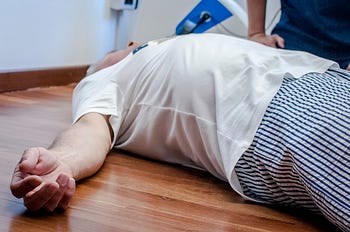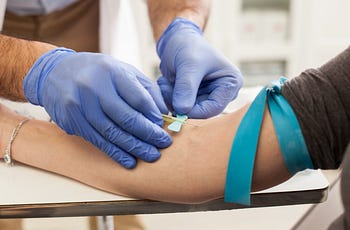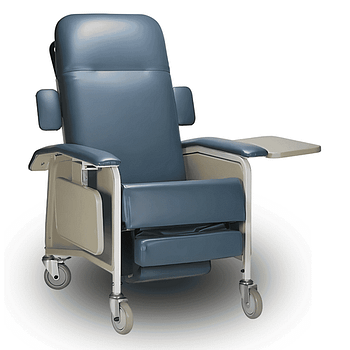Understanding Vasovagal Syncope: Part 2 - Recognition, Risk Factors, and Prevention
Spotting the warning signs, identifying high-risk patients, and preventing fainting episodes before they happen
by Shanise Keith • September 02, 2025
In Part 1 of this series, we explored the science behind vasovagal syncope – what happens in your patient's body during that dramatic cascade of physiological events. Now let's get practical. How do you spot a vasovagal reaction before your patient hits the floor? Who's most at risk? And most importantly, how can you prevent these episodes from happening in the first place.
After years of teaching phlebotomy and dealing with countless fainting episodes, I've learned that prevention is always better than reaction. The key is developing a sharp eye for warning signs and understanding which patients need extra precautions before you even touch them with a needle.
One person I saw faint during a blood draw was a teenager, probably about 17 or 18. He was lean and athletic. During his blood draw (with a student practicing on him), he passed out very quickly. I was across the room at the time, and happened to look up and noticed he was very pale. The student had his head down and was focused on the blood draw, not on the volunteer (one of his high school friends). By the time I got over to the station he was at, the volunteer had lost consciousness, slumping over in the chair.
It only took a few seconds from the time I saw him. I had the student pull the needle immediately, but as the student applied the safety, the volunteer suddenly stiffened… his eyes wide open, staring out blankly. As we watched, he stood up, eyes still wide, mouth agape. Arms were stiff at his sides, hands were in a claw shape. A strange moan rattled out of him. It was like something out of a horror movie.
It only lasted for a few seconds, and then his body relaxed again and we were able to get him out of the phlebotomy chair and onto the floor, but the image scared my classroom full of students and volunteers pretty badly. There was no harm done though, he was totally fine after a few minutes. When we told him what he had done he was shocked, and didn’t believe us at first. Of course he wouldn’t remember, he wasn’t conscious despite the open eyes and look of horror on his face.
I have seen a few faints like this, they are rare, and not typically what syncope looks like, but the body can do strange things when the brain begins to lose oxygen. In the next part of the series I will tell a story about what more common fainting looks like.
Recognizing the Warning Signs
The good news about vasovagal syncope is that it rarely happens without warning. The bad news is that those warnings can be subtle, and patients don't always recognize what they're feeling or know they should tell you about it. In the story above, the volunteer told me later that he had felt really hot and sweaty, but he wanted to help his friend and didn’t realize his symptoms meant anything. He thought it was just because he was nervous. The student (and everyone else in the room) learned a valuable and memorable (if somewhat dramatic) lesson about being vigilant in communicating and watching the patient throughout the blood draw.
So, what are all the main symptoms we need to look for?
The heat complaint: This is probably the most reliable early warning sign. Patients will often say things like "Is it warm in here?" or "I'm feeling really hot" even when the room temperature is comfortable. They might start fanning themselves or asking if you can turn up the air conditioning. Now that you understand the physiology from Part 1, you know this isn't about room temperature – it's about their blood vessels dilating and blood rushing to the surface. Take this complaint seriously, even if they seem fine otherwise.
Color changes: Watch your patient's face throughout the procedure. They might start looking pale, gray, or even slightly green around the gills. Sometimes the color change is subtle – they just don't look quite right. Trust your instincts. If something about their appearance seems off, pay attention. The color change is usually most dramatic around the mouth and eyes.
Vision complaints: Patients might mention that their vision is getting dim, "tunneling," or that things look blurry. They might say the room seems darker or that they're having trouble focusing. These are all signs that blood flow to the brain is starting to decrease.
The "weird" feeling: Many patients will tell you they feel "strange," "off," or "different" but can't quite articulate what's wrong. Don't dismiss this vague complaint. Their body is picking up on changes that their conscious mind can't quite identify yet.
Physical signs: Look for sweating (especially if the room isn't warm), fidgeting, restlessness, or sudden stillness. Some patients will get very quiet and stop talking, while others might become more talkative than usual. Both can be warning signs. Often you will hear people describe that a person who is about to faint will become kind of blank, just staring at nothing - when this happens you need to act quickly.
Nausea and dizziness: These classic symptoms are often later warning signs. By the time someone tells you they feel nauseous or dizzy, you're usually close to a full vasovagal response. These can also be present for a while afterwards as well.
Here's something crucial: don't be fooled by the "tough guy" syndrome. Some of the worst vasovagal reactions I've seen have been from patients who insisted they were absolutely fine, who bragged about never having problems with blood draws, or who seemed completely relaxed and confident. The body's vasovagal response doesn't care about your patient's attitude, confidence level, or how tough they think they are.
Also, contrary to what many people think, patients don't faint because they're holding their breath. That's a persistent myth. They might breathe differently due to anxiety, but the fainting is caused by that vasovagal cascade we discussed in Part 1, not by breath-holding (though breath holding doesn’t help).
If you notice any of these warning signs during or right before a blood draw, don't ignore them. Get that patient into a recumbent position immediately, even if you're in the middle of the procedure.
Who's Most at Risk?
While vasovagal syncope can happen to anyone, there are definitely patterns worth knowing about. Understanding these risk factors can help you identify patients who need extra precautions from the start.
Age factors: Research consistently shows that younger patients have higher rates of vasovagal responses. Teens and young adults seem to be particularly susceptible, possibly because their nervous systems are more reactive, or because they're more likely to be having their first or early blood draws and haven't developed coping mechanisms yet. However, don't let this fool you into thinking older patients are immune – I've seen plenty of 60 and 70-year-olds faint during blood draws.
Gender patterns: Most studies show that females have slightly higher rates of vasovagal reactions. However, in my experience, I've actually dealt with more males fainting than females. I think this might be related to young, lean, athletic males who have naturally lower blood pressure and heart rates. Their more vascular bodies and athletic conditioning might actually make them more susceptible to the vasovagal cascade. The research might not capture this because these patients don't fit the typical profile that studies focus on.
The anxiety misconception: Here's something important that many people get wrong – you don't have to be anxious or scared to have a vasovagal response. I've seen the most calm, relaxed patients suddenly faint, and I've seen extremely anxious patients who do just fine. While anxiety about needles or blood can certainly be a trigger for some people, the vasovagal response can happen purely from the physical stimulus of the needle or the sight of blood, regardless of the patient's emotional state.
This is why the "tough guy" patients can be so surprising. They're not anxious, they're not scared, they genuinely feel fine – and then their nervous system has a completely involuntary response to the procedure. It's not about mental toughness or emotional state; it's pure physiology.
First-time vs. repeat patients: Research clearly shows that first-time blood draw patients have much higher rates of vasovagal reactions. One study found that 4% of first-time blood donors had reactions compared to less than 0.6% of repeat donors. This makes sense – first-time patients don't know what to expect, they haven't learned their own warning signs, and their bodies haven't "practiced" the procedure before.
Physical factors: Here's where it gets interesting. Larger patients don't necessarily have fewer problems than smaller patients. In fact, I've seen some of the biggest, strongest-looking people have the most dramatic responses. Physical fitness level doesn't seem to be protective either – in fact, as I mentioned, I've noticed that athletes sometimes have more problems, not fewer.
Body weight does seem to matter, though. Research shows that patients with lower body weight have higher rates of vasovagal reactions, possibly because they have less blood volume to work with when that vasodilation occurs.
Previous experiences: Patients who have had negative experiences with blood draws in the past are definitely at higher risk. But here's the tricky part – some patients who have never had problems before can suddenly develop vasovagal responses. The body can essentially "learn" this response, which is why someone might be fine for years and then suddenly start having problems.
Medical conditions and medications: Patients taking blood pressure medications, especially ACE inhibitors or beta-blockers, may be more susceptible because their cardiovascular system has less ability to compensate for sudden changes. Diuretics can also be problematic because patients may be starting out slightly dehydrated.
Recent illness: Patients who are sick, or recovering from being sick, even if they feel fine now, may be more susceptible. Their bodies may still be in recovery mode, with slightly lower blood pressure or reduced blood volume.
Environmental Risk Factors
Several environmental factors can significantly increase the likelihood of a vasovagal response:
Room temperature: A warm room dramatically increases the risk. When the environment is already causing some vasodilation, the patient is much closer to that tipping point where their system can't compensate. I've definitely noticed that we see more fainting episodes on hot days, especially if the AC is struggling.
Time of day: Morning draws, especially early morning appointments, seem to have higher rates of problems. Patients may not have eaten recently, may be slightly dehydrated from sleeping, or their blood pressure may naturally be lower. There's something about that first appointment of the day that seems to catch people when their defenses are down.
Fasting status: Patients who haven't eaten in several hours are at higher risk. Low blood sugar combined with the stress of the procedure can be a perfect storm. This is especially common with fasting lab draws where patients come in having not eaten for 12+ hours.
Waiting time: Long waits before the procedure can increase anxiety and anticipation, both of which can contribute to vasovagal responses. That anticipation period can sometimes be enough to trigger the cascade before you even start the draw.
Prevention: The Power of Proper Positioning
Now for the most important part: how do we prevent these episodes from happening in the first place? The single most effective prevention strategy we have is proper patient positioning, especially for those with any history of problems.
The non-negotiable rule: If a patient gives you ANY history of issues during blood draws, they must be in a recumbent position for the procedure. By recumbent, I mean lying down at an angle of 20 degrees or less from horizontal. Not semi-recumbent, no 45 degree angles. 20 degrees or less. A reclining phlebotomy chair in the fully reclined position is ideal for this.
It is always my recommendation that instead of a classic phlebotomy chair, that a reclining phlebotomy chair is used. They are worth the investment. Anyone who begins to experience symptoms can be laid down easily and safely. Or the procedure can be performed with the patient in a recumbent position from the start.
Proper seating for all patients: Every patient getting blood drawn should be seated in a chair with arms on both sides. A phlebotomy chair is always preferred over a regular chair, and a reclining phlebotomy chair is best of all. Those arm rests aren't just for comfort – they're a safety feature that can prevent a patient from falling if they start to faint.
Hospital beds and exam tables: If your patient is on a hospital bed or exam table, they absolutely must be recumbent for the procedure. They cannot be sitting up on the edge of the bed or table. There are multiple instances where someone has fainted and fallen off of a table. The results from these situations include broken bones, paralysis, concussions, and even death. I have personally dealt with cases as an expert witness that involve severe injuries from fainting and falling off of a table. Don’t take the risk. If it’s an exam table or bed then just lay the patient down, even if it feels a little silly or “overkill” I promise you, it is worth it.
The refusal option: This might surprise some people, but if a patient really doesn't want to lie down for the procedure and they have a history of problems, you can refuse to do the draw. Patient safety trumps convenience every single time. It's not worth the risk to either of you. If this option is not a part of your facilities protocol then I suggest you get it added to help employees feel validated in enforcing this rule.
The History Question That Matters
How you ask about previous problems can make all the difference in getting honest, useful information from your patients.
What NOT to say: Don't ask, "Have you ever fainted during a blood draw?" Just hearing the word "fainting" can sometimes trigger anxiety and actually increase the likelihood of a reaction. It plants the idea in their head and can become a self-fulfilling prophecy.
What TO say: Try something like: "Have you ever had any issues or problems when having blood drawn before?" or "How do you usually do with blood draws?" These questions are more open-ended and less likely to create anxiety while still getting you the information you need.
Listen carefully: Pay attention not just to what they say, but how they say it. If they hesitate, if they say "Well..." or "I think I'm fine," that's often a sign that they've had problems before but are minimizing them. If they give you any history of problems – fainting, feeling dizzy, nausea, "not doing well," whatever – that patient needs to be recumbent for the procedure.
No exceptions: I don't care if they say, "Oh, but I feel fine today" or "It was just that one time" or "I ate a good breakfast this morning." If they have a history, they're lying down. Period. Don’t be afraid to ask clarifying questions if you need to, it’s better to know their history and lay them down for the procedure than to not ask and risk them fainting.
Additional Prevention Strategies
Beyond positioning, there are other things you can do to reduce the risk of vasovagal reactions:
Keep the room cool: If you have any control over the temperature, err on the side of cooler rather than warmer. A slightly cool room can help prevent that initial vasodilation that sets the stage for problems. I have seen phlebotomists provide a fan pointed in the direction of the patient. They give them the option of turning it on before they start, and if the patient ends up fainting it can also be used to help them recover.
Minimize waiting time: When possible, get patients in and out quickly. The longer they sit there anticipating the procedure, the more likely they are to work themselves up into a state where a vasovagal response becomes more likely.
Stay calm and confident: Your demeanor affects your patients more than you might realize. If you seem nervous or unsure, they'll pick up on that energy. Confidence is reassuring.
Use distraction: Engage patients in conversation about neutral topics. Ask about their weekend plans, their hobbies, anything that gets their mind off the procedure. Just avoid medical topics or anything that might increase their anxiety.
Proper hydration: While dehydration alone doesn't usually cause vasovagal syncope, it can certainly contribute. If a patient mentions they haven't had much to drink that day, encourage them to have some water before the procedure if possible.
The Bottom Line
Recognition and prevention of vasovagal syncope comes down to three key skills: knowing what to look for, understanding who's at risk, and implementing smart prevention strategies – especially proper positioning.
The most important thing to remember is that this isn't about judging patients or predicting who will be "tough enough" to handle a blood draw. Vasovagal syncope is a physiological response that can happen to anyone, regardless of their size, fitness level, or mental toughness. Your job is to recognize the warning signs, identify high-risk situations, and take appropriate precautions to keep everyone safe.
In Part 3 of this series, we'll cover exactly what to do when prevention doesn't work and a patient does faint during a blood draw. From immediate needle safety to complete recovery protocols, you'll know exactly how to handle these situations with confidence and professionalism.
What warning signs have you found most reliable in predicting vasovagal reactions? Have you noticed any patterns in your patient population that differ from what the research suggests?
Related Posts and Information
overall rating: my rating: log in to rate
faint fainting recumbent Syncope





